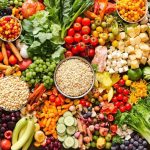
What is Intuitive Eating?
Before we look into the effectiveness of Intuitive Eating, it is crucial to explain what it is and what it isn’t.
A non-diet strategy for nourishment, Intuitive Eating encourages rebuilding a healthy relationship with food and one’s body through learning how to focus and trust your inner self.
The two Registered Dietitian Nutritionists, Evelyn Tribole and Elyse Resch founded the entity in 1995. This model has been proven to be accurate, with a proven evaluation system and up to 150 investigations to this point.
Intuitive Eating is constructed on 10 Guidelines that attempt to either improve or eliminate any difficulties with body awareness and create enduring habits that aid in both your emotional and physical wellbeing.
What Intuitive Eating is Not
It is essential to be informed on Intuitive Eating, but comprehending misconceptions and beliefs which prove to be untrue can be even more valuable in deciding if it is effective.
- Intuitive Eating is not a fad diet. Although Intuitive Eating has become trendy, it isn’t just another fad. Intuitive Eating is a paradigm shift that aligns with the principles of Health at Every Size. It’s a whole movement focusing on inclusivity and access to care that’s only going to continue to grow. This is what the future is moving toward, and that’s a good thing!
- It’s not just relying on internal cues instead of tracking macros or calories to reach your physique goal. A common misconception in the fitness community is that Intuitive Eating is simply a lack of tracking macros and instead just eye-balling potions and listening to internal cues. However, eating intuitively and Intuitive Eating is not the same thing.
Intuitive Eating is an approach to nourishment that seeks to mend the connection between food, your body, and the self. Eating intuitively implies listening to your body’s signals and engaging in food choices based on those particular signals.
- It’s not a non-diet approach to weight loss. First off, a non-diet approach to weight loss is an oxymoron. This is literally just diet culture (looking at you, Noom) co-opting the language of Intuitive Eating since it’s gaining so much popularity. Weight control, caloric restriction, and labeling foods work against Intuitive Eating. Calling a weight control program “non-diet” is just harmful and confusing.
- It’s not the hunger-fullness diet. As I stated previously, tuning into internal body cues is just a small part of Intuitive Eating. Doing so with the sole purpose of controlling weight can impede the goals of Intuitive Eating.
- It is not the same as mindful eating. While mindfulness is a part of intuitive eating, there is more to it than that.
- It’s not anti-weight loss. Just because weight isn’t the focus or the end goal with Intuitive Eating, doesn’t mean that it’s anti-weight loss. If someone loses weight (or gains) with Intuitive Eating, that’s fine, but you are so much more than your body or your weight, and as I’ll dig into more in a bit, health is so much more complex than weight alone.
How Does Intuitive Eating Work?
The basic idea is straightforward – enjoying whatever food you like, whenever you like – but following a set of 10 key parameters is essential for intuitive eating. Alissa Rumsey, MS, RD, a certified intuitive eating counselor and proprietor of Alissa Rumsey Nutrition and Wellness, claims the arrangement of these ideas is cautiously planned, each progression heading to the following one. That means it’s essential to master each principle in order, one by one:
1. Reject a diet mentality
Rumsey states that in order to practice mindful eating, one must first reject the promises and messages of diets by breaking away from preconceived notions about food. She suggests you cease following and remove your subscription to any social media accounts and lists that advertise dieting in order to achieve your goal.
2. Eat when you’re hungry
Jessica Cording, a Registered Dietitian, claims that the body can effectively express its need for food. Diet culture. It can be difficult for people to have faith in their instincts due to feelings of anxiety and fear.
Not sure you’re in tune with your body’s signals? Every time you have the intention of eating, Cording proposes that you assess your hunger level using a rating system of one to ten. By engaging in the activity, you can accustom yourself to paying attention to your body’s signals.
3. Make peace with food
Regulations concerning the foods someone is or isn’t allowed to consume in makeup diets are usually expressed with very powerful language. Rumsey noted that people usually have the hardest time with intuitive eating while they’re stuck on a diet mentality of labeling certain foods as either ‘good’ or ‘bad’. She encourages paying attention to all the dishes that bring pleasure and makes one feel content.
4. Challenge feelings of guilt around food
A lot of us have a complicated relationship with sustenance, considering the way it has an impact on both our wellbeing and body shape. We can undeniably connect our emotions to food, whether that connection encompasses sentiments of perfectionism, guilt, shame, or desperation.
To be successful at intuitive eating, it is essential to redefine one’s food decisions from being limited to selections, to staying as tolerant, noncondemning, and pliable as practicable. “It’s about self-care rather than self-control,” says Rumsey.
5. Respect feelings of fullness
It may be difficult to accurately detect our body’s cues because of experiences in our history such as not succeeding in past diets, attempting to fit into predefined social standards by eating in minor portions, or being exposed to contentious perspectives about food inside our families. Attempt to distance yourself from those feelings and instead concentrate on the sensation of satiety from your body when you eat. Cording states that pausing to rest between mouthfuls can assist in allowing the brain and body to match one another.
6. Eat to feel satisfied
Rather than looking at food as off-limits, consider it a source of pleasure. Cording asserts that it is necessary to eat both nutritious foods and more delightfully gratifying foods, and decide which to eat based on what one truly desires and needs.
You are allowed to eat whatever you like at any time. Rumsey discusses how our dietary practices have led us to misconstrue that we can indulge in as much sugar as we want – however, it does not need to be that way. Rumsey encourages people to heed their own minds when deciding what to eat and base that decision on being kind to their bodies and promoting wellbeing. At times, one might opt for a plate of macaroni and cheese, while on other occasions they could select a bowl containing kale and quinoa salad. Both are perfectly valid choices.
7. Find alternatives to address emotions other than eating
We all eat emotionally sometimes—we’re human! It’s not necessarily a bad idea to use food to manage challenging situations when following Intuitive Eating. Rumsey expresses concern when food is being relied on as the predominant way of managing emotions.
Do you eat for emotional reasons? Rumsey and Cording propose making a note of your emotions in a diary every time you eat in order to reconnect with your body’s indicators of appetite, satiety, and fulfillment. Do not bother to track what you eat, as that could end up turning into an obsessive monitoring of calories and nutrients.
If you identify that a particular feeling or mood causes you to eat, try not to deny yourself when it comes up. Rather than eating, search for means of calming yourself from feelings of strain, unease, dejection, or any thing that spurs you to eat such as exercising, writing, phoning a friend, studying, or taking some deep breaths. A mental health expert and/or a qualified nutritionist can assist you in going through this process.
8. Accept your body shape
The objective of intuitive eating has nothing to do with slimming down or altering one’s physical body structure or appearance. Rumsey states that if one does not completely give up on diet mentality and the desire to be thinner, they are more likely to have difficulty achieving the tranquility that is associated with intuitive eating. “Try to show yourself compassion.”
9. Exercise to feel good
Many people tend to treat exercise and diets as the same, so that is why “intuitive movement” is numbered among the 10 key principles of intuitive eating. You need to consider, “What does my body require today?” or “What sort of movement do I feel like doing?” Rumsey is inquiring as to what form of physical activity would be most advantageous for her body at the present moment.
10. Eat to honor your health, with “gentle nutrition” choices
Eating intuitively does not mean following a meal plan or restricting yourself from eating certain foods, such as desserts. Rather than making decisions about food out of a need for self-discipline, “gentle nutrition” looks at how we listen to the messages of our body and use what we know about nutrition to make mindful choices with care for ourselves. Rumsey states that the critical aspect is to decide based on respecting your wellbeing, not because of some lingering diet culture influences. Allowing yourself to be accepting of various possibilities can help you discover what kind of sustenance is best for your own body.
Jessica Cording, a registered dietician, holds the opinion that intuitive eating is not easy, but it can still be useful no matter a person’s situation.
Can the majority of people get to the point where they genuinely desire healthy, unrefined, and unpackaged foods that nutritionists recommend? Intuitive eating fans say yes. Rumsey comments that the majority of individuals who have made a truce with sustenance and are respecting their cravings have a tendency to move towards having more organic products and vegetables.
For some, the decision to consume nutritious foods like vegetables may not stem from a desire for them, but more so from a conscious selection to make self-care the priority. “This is where gentle nutrition comes in,” Rumsey says. We motivate ourselves to discover how to take pleasure in more of the foods that are beneficial for our bodies. She provides an example of a customer who wanted to try different vegetables prepared in different ways and was successful in finding ones that she liked and that made her feel healthy.
Why Intuitive Eating Doesn’t Work for You: Trouble-Shooting
You’ve Turned the Intuitive Eating Principles into Rules
It’s human nature to turn things black and white. It is easier when an action has an appropriate way to be done and an incorrect way to be done. This especially holds true with eating. It brings peace of mind to be aware that there are strict regulations that can result in a final result. But eating is complex, nuanced, and personal. Intuitive Eating acknowledges that.
There is no definitive answer as to how to approach Intuitive Eating. The principles are merely suggestions, not regulations, and some of the suggestions may not fit for everybody.
What to do about it?
Let go of your expectations. Realize that the process of Intuitive Eating is a continuous pursuit without an endpoint. Despite having a tough day, week, or even month, it doesn’t mean you are a failure. Be kind to yourself, seek out help, and recognize the progress you have made.
You Don’t Trust Your Body
Trust is a key aspect of Intuitive Eating.
Believe in your body and be mindful of the signals coming from within.
It is not surprising that many people are skeptical of their physical form, especially after being taught through various eating regimens to not rely on their body’s signals.
Concentrating on external regulations like part sizes, macro-nutrients, time limits, and the excluding of some foods in your diet fails to take into account your individual needs. By not heeding what your body is telling you, you basically hand control over to the instructions of the specific diet. View your body as requiring management.
But trust can be rebuilt. It takes determination and effort, but the more you revere and have confidence in your body, the simpler the process will be.
You’re still Trying to Lose Weight
Not all individuals that practice Intuitive Eating will experience weight loss, and if they do, it is not the primary purpose of the approach. If you have an unconscious or conscious wish to lose weight, it will impede the practice of Intuitive Eating.
If you are looking to shed pounds, you may still experience outside influences. It will be impossible to find harmony with nourishment and once again link with your inner knowledge.
Classifying certain foods as “positive” and others as “negative”
If you keep considering certain foods as superior to others, it will be difficult to be aware of your wants since there will still be a certain degree of limitation.
When we deny ourselves the chance to have something, it can make us want it that much more. This is the way our brains are naturally programmed, and scientific research has demonstrated this fact.
Once the restriction has been fully healed, the temptations of forbidden foods will no longer be as prominent, however, if the restriction persists then the healing process will not be completed. There will still be a feeling of helplessness and lack of power.
You Don’t Have Support
Intuitive Eating is a process with ups and downs. It can be difficult to overcome, particularly if you exist in an environment that reveres slimming down and meal plans. Without support, it can feel confusing and isolating. It is critical to seek help, whether through a mentor, a person who has experienced it, or an internet-based support network.
You Tried to do too Much at Once
It is not necessary and it is not advisable to attempt to put all the rules into practice simultaneously. This will feel incredibly overwhelming and difficult. You may have a lack of control associated with your diet, which can be quite frightening and cause you to think you’re not doing well.
Instead, start slow. Select two standards to investigate and put into practice before launching another one.
Food is your Main Coping Mechanism For Feeling
Making food a source of comfort can be a totally ordinary and beneficial part of your diet.
For instance, it is acceptable if [baking cookies] evokes memories of making treats with your grandmother when you were a kid and it relieves some of your tension while you’re facing difficulties. Turning to food as a solution for emotional distress can eventually become an issue if it is the only way of dealing with negative emotions such as loneliness, tension, or grief, or if it leads to feeling guilty.














